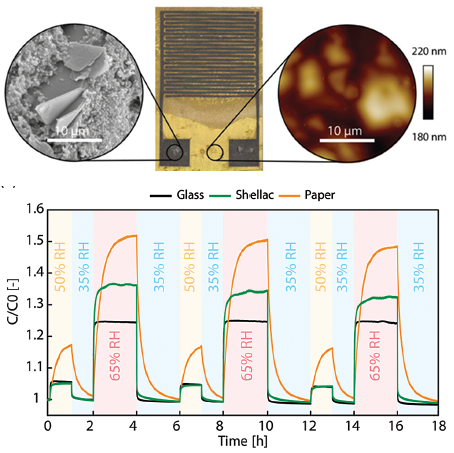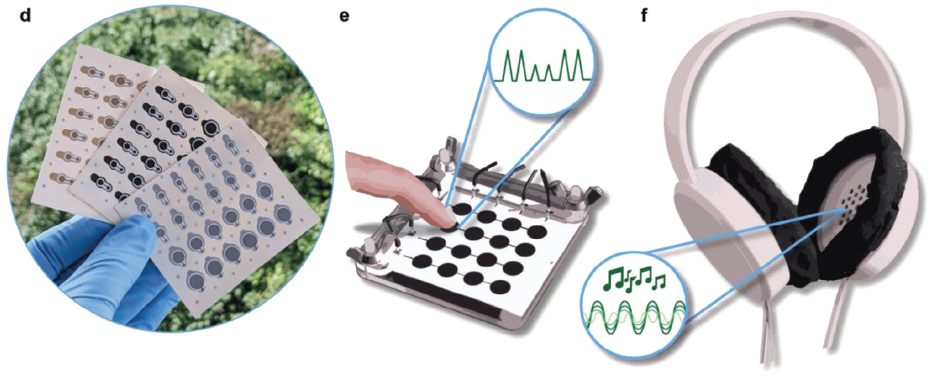The scope of this research is to develop eco-friendly transient microsystems that can naturally disappear either in the environment (biodegradable), or when implanted in the human body (bioresorbable). We are researching the integration of eco-friendly functional materials using scalable and flexible solution processing techniques such as additive and digital manufacturing.
Developing these systems is particularly challenging due to chemical and temperature compatibility issues with the different functional and structural materials. We are working towards developing techniques overcoming material incompatibilities, working towards fabricating fully degradable printed electronics. We are also investigating the transient and degradation properties of the components and their integration into systems for given applications.
Our current work includes:
- Formulation of functional inks and development of additive manufacturing processes (i.e. printing) to pattern functional biodegradable materials: conductors, dielectric and semiconductors, on soft bio-polymers and paper substrates;
- Investigation of low-temperature post-treatments such as photonic sintering and deep-UV curing processes;
- Fabrication of devices for novel green or biomedical applications, in such fields as smart food packaging, environmental and health sensing, IoT, wearables, and implantable systems.
Here are some of our realisations of transient electronics, sensors, and microsystems:
Humidity and temperature sensors made of carbon and shellac;

Figure 1: Humidity and temperature sensing platform made of renewable materials.
Biochemical sensors based on organic thin film transistors (OTFT) and organic electrochemical transistors (OECTs) on poly-lactic acid (PLA), for the detection of ions, metabolites, etc;

Figure 2: OECT sensors made on PLA substrate and their biodegradation in soil over time.
Degradable Zinc conductors printed and sintered using a patented hybrid process compatible with temperature substrates and enabling high conductivity and stability;
Green piezoelectric sensors and actuators printed on paper with integrated degradable carbon/zinc electrodes, with applications as touch pads and microspeakers;

Figure 3: Sensing and actuating piezoelectric microsystems made on paper.
Ecoresorbable and bioresorbable RTD sensors made of printed zinc conductors on paper and biopolymers;
Bioresorbable pressure sensors with wireless and chipless operation and made of zinc embedded in PLA;

Figure 4: Zinc based eco-resorbable and bioresorbable sensors.
3D printed customizable bioresorbable soft electronics: carbon based electrodes, strain and pressure sensors, embedded into an elastomeric POMaC matrix, all deposited by Direct Ink Writing (DIW).
Contact person
Funding
Swiss National Science Foundation (SNF)
Scientific publications
M. Monroe, G. Villanueva, D. Briand, Additively manufactured degradable piezoelectric microsystems for sensing and actuating, Advanced Materials Technologies (2023) 2300745.
N. Fumeaux, C. Pinto Almeida, S. Demuru, D. Briand, Organic electrochemical transistors printed from degradable materials for use as disposable biochemical sensors (2023) 13:11467.
N. Fumeaux, M. Kossairi, J. Bourely, D. Briand, Printed ecoresorbable temperature sensors for environmental monitoring, Micro and Nano Engineering, 20 (2023) 100218.
N. Fumeaux, D. Briand, Zinc hybrid sintering for printed transient sensors and wireless electronics, npj Flexible Electronics (2023) 7:14.
M. Monroe, G. L. Villanueva, D. Briand, Low temperature processing of screen printed piezoelectric KNbO3 with integration onto biodegradable paper substrates, Microsystems and NanoEngineering (2023) 9:19.
J. Bourely, L. De Sousa, N. Fumeaux, O. Vorobyov, C. Beyer, D. Briand, Biodegradable materials as sensitive coatings for humidity sensing in S-band microwave frequencies, Micro Nano Engineering (2023) 19, 100185.
X. Aeby, J. Bourely, A. Poulin, G. Siqueira, G. Nyström, D. Briand, Printed humidity sensors from renewable and biodegradable materials, Advanced Materials Technologies, 2022, 2201302.
G. Mattana, D. Briand, A. Marette, A. Vásquez Quintero, & N. F. de Rooij (2015) Polylactic acid as a biodegradable material for all-solution-processed organic electronic devices, Organic Electronics, 17, 77-86.
A. Vásquez Quintero, N. Frolet, D. Marki, A. Marette, G. Mattana, D. Briand, & N. F. de Rooij (2014). Printing and encapsulation of electrical conductors on polylactic acid for sensing applications. In Proceedings of the Micro Electro Mechanical Systems (MEMS) conference, IEEE 27th International Conference, 532-535.